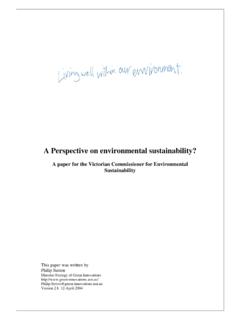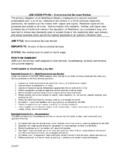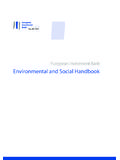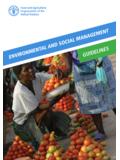Transcription of Human Rights, Health & Environmental Protection: …
1 Health and Human rights Working Paper Series No 1 Human rights , Health & Environmental protection : linkages in Law & Practice A Background Paper for the World Health Organization Dinah Shelton Professor of Law, Notre Dame London Law Centre, London 2002 This is a working paper, and hence it represents research in progress. This paper represents the opinions of individual authors and is the product of professional research. It is not meant to represent the position or opinions of the WHO or its Members, nor the official position of any staff members. Any errors are the fault of the authors. This information product is intended for a restricted audience only. It may not be reviewed, abstracted, quoted, reproduced, transmitted, distributed, translated or adapted, in part or in whole, in any form or by any means. The World Health Organization does not warrant that the information contained in this Health information product is complete and correct and shall not be liable for any damages incurred as a result of its use.
2 2 TABLE OF CONTENTS EXECUTIVE SUMMARY ..3 I. SELECTED TREATY & OTHER PROVISIONS LINKING Human rights , Health & A. Human rights INSTRUMENTS WITH PROVISIONS ON Health AND THE ENVIRONMENT ..6 B. Environmental INSTRUMENTS WITH PROVISIONS ON Health AND Human rights ..7 II. THE JURISPRUDENCE AND COMMENTS OF Human rights 1. Human rights COMMITTEE ..12 A. GENERAL B. COMMUNICATIONS ..12 2. COMMITTEE ON ECONOMIC, SOCIAL AND CULTURAL rights ..14 A. PERIODIC B. GENERAL 3. COMMITTEE ON THE ELIMINATION OF DISCRIMINATION AGAINST WOMEN ..15 4. COMMITTEE ON THE rights OF THE 5. REGIONAL SYSTEMS ..15 A. PETITIONS ..16 B. COUNTRY STUDIES ..16 III. NATIONAL LAW AND IV. THE rights -BASED APPROACHES TO Health AND Environmental protection ..23 3 Executive Summary International concerns with Human rights , Health and Environmental protection have expanded considerably in the past several decades.
3 In response, the international community has created a vast array of international legal instruments, specialized organs, and agencies at the global and regional levels to respond to identified problems in each of the three areas. Often these have seemed to develop in isolation from one another. Yet the links between Human rights , Health and Environmental protection were apparent at least from the first international conference on the Human environment, held in Stockholm in 1972. Indeed, Health has seemed to be the subject that bridges the two fields of Environmental protection and Human rights . At the Stockholm concluding session, the participants proclaimed that: Man is both creature and moulder of his environment, which gives him physical sustenance and affords him the opportunity for intellectual, moral, social and spiritual growth.. Both aspects of man=s environment, the natural and the man-made, are essential to his well-being and to the enjoyment of basic Human rights even the right to life Principle 1 of the Stockholm Declaration established a foundation for linking Human rights , Health , and Environmental protection , declaring that: Man has the fundamental right to freedom, equality and adequate conditions of life, in an environment of a quality that permits a life of dignity and well-being.
4 In resolution 45/94 the UN General Assembly recalled the language of Stockholm, stating that all individuals are entitled to live in an environment adequate for their Health and well-being. The resolution called for enhanced efforts towards ensuring a better and healthier environment. 1 Stockholm Declaration of the United Nations Conference on the Human Environment, 16 June 1972, Doc. A/. at 3 (1973). In the three decades since the Stockholm Conference, the links that were established by these first declaratory statements have been reformulated and elaborated in various ways in international legal instruments and the decisions of Human rights bodies. In large part, these instruments and decisions involve taking a rights -based approach to the topics, albeit with different emphases. The first approach, perhaps closest to that of the Stockholm Declaration, understands Environmental protection as a pre-condition to the enjoyment of internationally-guaranteed Human rights , especially the rights to life and Health .
5 Environmental protection is thus an essential instrument in the effort to secure the effective universal enjoyment of Human rights . Klaus Toepfer, Executive Director of the United Nations Environment Programme, reflected this approach in his statement to the 57th Session of the Commission on Human rights in 2001: 4 Human rights cannot be secured in a degraded or polluted environment. The fundamental right to life is threatened by soil degradation and deforestation and by exposures to toxic chemicals, hazardous wastes and contaminated drinking water. Environmental conditions clearly help to determine the extent to which people enjoy their basic rights to life, Health , adequate food and housing, and traditional livelihood and culture. It is time to recognize that those who pollute or destroy the natural environment are not just committing a crime against nature, but are violating Human rights as well.
6 The General Assembly similarly has called the preservation of nature a prerequisite for the normal life of man. 2 The second rights -based approach, most common in international Environmental agreements since 1992, is also instrumentalist, but instead of viewing Environmental protection as an essential element of Human rights , it views certain Human rights as essential elements to achieving Environmental protection , which has as a principal aim the protection of Human Health . This approach is well-illustrated by the Rio Declaration on Environment and Development, adopted at the conclusion of the 1992 Conference of Rio de Janeiro on Environment and Development. It formulates a link between Human rights and Environmental protection largely in procedural terms, declaring in Principle 10 that access to information, public participation and access to effective judicial and administrative proceedings, including redress and remedy, should be guaranteed because Environmental issues are best handled with the participation of all concerned citizens, at the relevant level.
7 Thus, these procedural rights , contained in all Human rights instruments, are adopted in Environmental texts in order to have better Environmental decision-making and enforcement. The third, and most recent approach views the links as indivisible and inseparable and thus posits the right to a safe and healthy environment as an independent substantive Human right. At present, examples of this are found mainly in national law and in regional Human rights and Environmental treaties. Most formulations of the right to environment qualify it by words such as healthy , safe , secure or clean , making clear the link between Environmental protection and the aim of Human Health . It should be noted that there are other regulatory approaches to achieving Environmental protection and public Health that are not rights -based. Economic incentives and disincentives, criminal law, and private liability regimes have all formed part of the framework of international and national Environmental law and Health law.
8 This emphasis on responsibilities rather than rights echoes language from the Stockholm Declaration and subsequent instruments that emphasize the duty of each person to protect and improve the environment for present and future generations. It is also consistent with Human rights instruments that affirm the duties of each individual to others to promote and observe internationally-guaranteed Human 2 GA Res. 35/48 of 30 October 1980. 3 See, , Universal Declaration of Human rights , Pmbl, Art. 1, Art. 29; International Covenant on Economic, Social and Cultural rights , (16 Dec. 1966), 993 3, Pmbl ( the individual, having duties to other individuals and to the community to which he belongs, is under a responsibility to strive for the promotion and 5 The following materials examine (1) treaties and declarations in the fields of Human rights and Environmental protection , (2) the decisions of Human rights bodies, that link Human rights , Health , and Environmental protection and (3) national constitutional provisions, laws and jurisprudence that link the three topics.)
9 Following this presentation, the paper concludes with an evaluation of the rationales supporting rights -based approaches to issues of Health and Environmental protection . observance of the rights recognized in the present Covenant ), Art. 5. 6I. Selected Treaty & Other Provisions Linking Human rights , Health & Environment a. Human rights Instruments with Provisions on Health and the Environment Most Human rights treaties were drafted and adopted before Environmental protection became a matter of international concern. As a result, there are few references to Environmental matters in international Human rights instruments, although the rights to life and to Health are certainly included and some formulations of the latter right make reference to Environmental issues.
10 The International Covenant on Economic, Social and Cultural rights (16 December 1966), guarantees the right to safe and healthy working conditions (Art. 7 b) and the right of children and young persons to be free from work harmful to their Health (art. 10-3). The right to Health contained in article 12 of the Covenant expressly calls on state parties to take steps for the improvement of all aspects of Environmental and industrial hygiene and the prevention, treatment and control of epidemic, endemic, occupational, and other diseases. The Convention on the rights of the Child (New York, November 20, 1989) refers to aspects of Environmental protection in respect to the child=s right to Health . Article 24 provides that States Parties shall take appropriate measures to combat disease and malnutrition through the provision of adequate nutritious foods and clean drinking water, taking into consideration the dangers and risks of Environmental pollution.

















